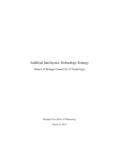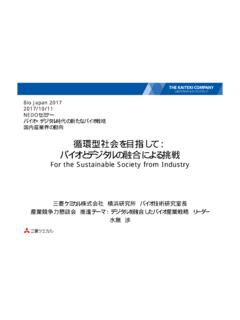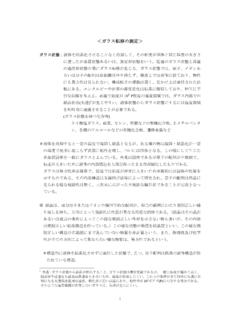Transcription of Registration number 2002IS002 ISO Standardization …
1 S-02 Registration number 2002IS002 ISO Standardization for Active magnetic Bearing Technology Research coordinator Osami Matsushita National Defense Academy:Japan Research team member Yoich Kanemitsu Kyushu Unversity:Japan Makoto Itou Shinkawa Sensor Technology:Japan Naohiko Takahashi Hitachi Industries:Japan Eric Maslen University of Virginia:USA Richard Markert Darmstadt Tech.:Germany Lawrence Hawkins Calnetix: USA Kevin Bornstein Waukesha magnetic Bearings:USA Duration: Apr. 2002 Mar. 2005 Abstract Since the ISO TC108/SC2/WG7 AMB project was established in 1996, the Standardization of active magnetic bearing (AMB) technology has been continued to expand AMB applications.
2 Meantime, our project, supported by the NEDO grant, worked from FY2002 to FY2004 as the main members of WG7. The following three parts have been developed: ISO 14839-1 Vocabulary ; published in May, 2002. ISO 14839-2 Evaluation of vibration ; published in July, 2004 ISO FDIS 14839-3 Evaluation of stability margin ; will be published in May, 2006. Particularly, since Part 3, stability margin of AMB control systems, is a new subject not seen in conventional standards, a consensus has been missing for a long time due to each company s internal knowledge. To resolve this dead lock, international collaborative test was successfully achieved in a three-year-program.
3 This collaboration finally created the consensus and accelerated the Standardization process toward publication. Our activity was given by the JSME "Standards Board Contribution Award" (2005). Keywords: Active magnetic bearing, ISO, Vibration evaluation, Evaluation of stability margin, Rotating macine 1. Introduction As core members of ISO TC108/SC2/WG7 Active magnetic Bearing (AMB) project (Convenor Osami Matsushita, Japan), our NEDO team has been developing an ISO 14839 series for AMB rotating machinery. The following three standards, registered by ISO CS, have progressed; ISO 14839-1 Vocabulary (published in May, 2002 ISO 14839-2 Evaluation of vibration (published in September, 2004) ISO FDIS14839-3 Evaluation of stability margin (now in the editing process for the final voting) ISO Directives requires a voting process at each stage consisting of WD(Working Draft)-CD(Committee Draft)-DIS(Draft of International Standard)-FDIS(Final DIS) for publication.)
4 Part 1 was published in 2002 after our final revision of the draft. Part 2 was developed for AMB turbo machinery as well as vibration standards for machines equipped with conventional bearings. At the early stage, we considered both the maximum values of vibration and AMB working current as the index to be regulated. No agreement was reached due to lack of adequate field data. Finally, we stated the vibration regulation in the main text and allocated the current regulation in the appendix. This compromise was made at the Tokyo meeting(2002) to agree with DIS of Part 2.
5 Afterwards, it was published in 2004. Part 3 was our main target. At the beginning, we encountered conflicting ideas regarding the stability margin, the difference from Q-value(ISO 10814), how to measure the stability margin using commercial FFT analyzers and etc. In order to resolve this non-productive situation, we invited experts from several countries to collaborate on testing according to the following 3-year plan: FY2002 Planing of test rigs (Design a test rotor offered by Hitachi Industries, Co., Ltd) FY2003 Setup of test rig (Manufacturing test rotor rigs and a digital controller for AMB) FY2004 Collaborative testing called NEDO-ISO Joint Workshop (Conference and test exhibition) Existing disagreements in the past were effectively solved by this workshop exhibiting vibration and stability analysis of AMB rotor and obtained test data.
6 Successful experiences of applying Part 3 to actual machines were reported by company experts at the workshop conference. This workshop was most effective opportunity to agreement of DIS advancing the next step. The Japanese team published a book titled Technical guidelines for AMB rotors in Japanese and the English version is available on the website. It will be referred to in Part 4 titled Technical guidelines. 2. ISO 14839-1 : Vocabulary [4]As we know, a new technology tends to produce new commercial terminology for the business propaganda. We also experience the confusion with dialects defined by individual companies and academies.
7 There are so many cases of this nature in AMB business communication. In addition, AMB is a combined technology with mechanical and electrical engineers. We needed to define the AMB-related-vocabulary to make the bridge between both fields. Part 1, titled Vocabulary contains six chapters as follows: 1. General, 2. Rotors, 3. Stators, 4. Sensors 5. Dynamics, control and electronic and 6. Auxiliary equipment Several definitions are shown from Part 1 as follows: (1) Symbol of AMB For rotating machinery equipped with active magnetic bearings, the graphical symbols for bearing are shown in (2) Active magnetic bearing, AMB means to support a rotor, without mechanical contact, using only attractive magnetic forces based upon servo feedback technology which normally consists of sensors, electromagnet, power amplifiers, power supplies and controllers, as shown in (3) AMB system system consisting of a rotor, position sensor or other means to detect rotor position, controller(s)
8 , power amplifier and electromagnets to levitate and support the rotor by attractive magnetic force, as shown in and 3. (4) unbalance force rejection control special control method which allows the rotor to rotate around its principal axis of inertia while the transmitted unbalance force through the AMB is minimized, which leads to resulting vibration of the bearing casing, as shown in This definition is a typical example of defining the commercial wording. 3. ISO 14839-2 : Evaluation of vibration [5,6] Background Most turbomachinery is still supported by oil-film bearings. Because of the high stiffness of oil-film bearings and very small clearances, , C/R = (bearing radial clearance) /(journal radius) 1/1000, shaft vibration must be regulated within low levels to avoid oil-film rupture of the lubricant and metal contact inside the bearing, as stated in the ISO 7919 series for turbines, generators, pumps, compressors, etc.
9 In contrast, since AMBs support the rotor softly in large bearing clearance, C/R 5/1000, large vibratory motions should be permissible as long as they do not produce rubs between the rotor and surround casing. In addition, the design of AMB for effective vibration control requires placement of the AMB actuator and its position sensor near the largest amplitude portion of the eigenmodes, as shown in Thus, the detection of large vibration is inevitable and can be allowable. This is the reason why AMB rotors require their own ISO standards.
10 Existing Standards In the case of a process compressor equipped with AMB, a customer can comply with API617 regulation[3] which requests a low vibration level as follows: and mpp, where =max. continuous speed, rpm. vLMCSNFor instance, if rpm, mpp 9500= the existing ISO standard concerning the journal vibration of turbomachines equipped with the oil-film bearing is applied, the vibration zone limit values would be as follows: ISO 7919-3 Coupled industrial machine[2] Zone A NS/4800=PP where N= the maximum (trip) speed For instance, if N =12500 rpm, Spp=43 mpp for Zone A.









